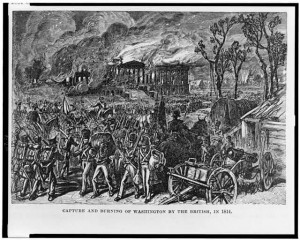 Two hundred years ago today, President James Madison set pen to paper to write a message to Congress. His intent was to talk them into making the nation’s first formal declaration of war – on Great Britain, which was squashing U.S. exports as a side effect of a British naval blockade against Napoleon’s France.
Two hundred years ago today, President James Madison set pen to paper to write a message to Congress. His intent was to talk them into making the nation’s first formal declaration of war – on Great Britain, which was squashing U.S. exports as a side effect of a British naval blockade against Napoleon’s France.
But that flow of ink had many unintended consequences – among them, the eventual conversion of a Library of Congress that consisted of a few hundred law books tucked into the recesses of the U.S. Capitol to the multifaceted house of knowledge it is today – with 151.8 million items on some 838 miles of bookshelves, offering more than 34.5 million books and other printed materials, 3.3 million recordings, 13.4 million photographs, 5.4 million maps, 66.6 million manuscripts and of course the website where you probably found this blog among its 31.4 million files.
Madison got his war – we know it as the War of 1812. Hostilities ensued. The British torched several public buildings in Washington in August of 1814, including Congress and its library.
Within a month, retired President Thomas Jefferson offered his personal library as a replacement. He had spent 50 years accumulating books, “putting by everything which related to America, and indeed whatever was rare and valuable in every science.” There were 6,487 books in the collection; their subject matter was much broader than law and many were in languages other than English.
Congress debated whether to take Jefferson up on his offer. But Jefferson replied, “There is, in fact, no subject to which a member of Congress may not have occasion to refer.” They agreed to buy his library for $23,950, and a whole new Library of Congress was born – one with a comprehensive collections policy that has become the largest library in the world.
You can still see Thomas Jefferson’s library, including thousands of books he personally purchased and then made available to the nation, in an exhibition in the Library of Congress’ Thomas Jefferson Building. You can also learn more about them here.
Postscript: Madison not only got his war, but he, too, eventually got his own building – the James Madison Building of the Library of Congress on Capitol Hill, which is his official memorial. This blog post comes to you from inside its walls.

June 3, 2012 at 4:39 pm
A personal tragedy for Jefferson, the loss of his personal library, yet a great building-stone in the development and prestige of the Library of Congress..